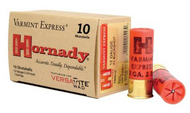How Far Do Shotgun Pellets Travel?
Aug 18th 2023
The distance shotgun pellets travel is a fundamental consideration for anyone using a shotgun. When a shotgun is discharged, it propels a cluster of small metal pellets called shot. The range that these pellets can cover varies depending on factors such as the type of ammunition, the shotgun's design, and the intended purpose. In most cases, shotgun pellets can travel several hundred yards. However, their accuracy and effectiveness tend to decline as they travel farther.
Shotgun pellets are typically effective at short to moderate ranges, where their spread pattern remains dense enough to hit a target effectively. Beyond a certain distance, the shot pattern begins to spread out, reducing the chances of multiple pellets hitting the target simultaneously. This diminishing pellet density can lead to decreased stopping power and a reduced likelihood of a clean, humane kill.
How Far Does 12 Gauge Buckshot Travel?
The distance that 12-gauge buckshot can travel is an important consideration for hunters and shooters. Buckshot is a type of shotgun ammunition that consists of larger pellets, usually ranging from 000 to 4 buck sizes. The effective range of 12-gauge buckshot is generally limited to around 40 to 50 yards. Within this range, the pellets maintain a tighter spread pattern, providing a higher chance of hitting the intended target.
As buckshot pellets travel farther from the shotgun's muzzle, the spread pattern becomes more pronounced. This can result in a wider impact area, decreasing the overall impact energy per pellet. Hunters using 12-gauge buckshot should be aware of this effective range and practice shooting within it to ensure accurate and ethical shots.
When Do Shotgun Pellets Start To Spread?
The spread of shotgun pellets begins almost immediately after they exit the shotgun's barrel. However, the degree of spread and the rate at which it occurs are influenced by various factors. One critical factor is the choke, which is a constriction at the muzzle end of the shotgun barrel. Different choke types, such as full choke or improved cylinder, affect the spread pattern.
With a tighter choke, the pellets stay more closely grouped for a longer distance, resulting in a denser pattern. As the pellets travel downrange, they gradually spread out due to their natural dispersal characteristics. This is why shotguns with tighter chokes are often favored for longer shots, where maintaining a more compact pattern is crucial for accuracy.
How Far Is A Shotgun Slug Effective?
Shotgun slugs are single, solid projectiles that are an alternative to traditional shotshell loads. The effective range of a shotgun slug can vary depending on factors like the slug's design, the shotgun's barrel type, and the shooter's skill level. Modern shotgun slugs fired from rifled barrels can offer accuracy and stopping power at distances exceeding 100 yards.
Unlike pellets, which disperse rapidly, shotgun slugs maintain their trajectory for a more extended distance. This makes them suitable for scenarios where longer shots might be necessary, such as hunting larger game like deer. However, even with their extended range, accuracy can start to decrease beyond a certain distance due to factors like bullet drop and the slug's ballistic properties.
What Distance Should I Shoot A Deer With Buckshot?
When it comes to using buckshot for deer hunting, shot placement and effective range are critical. The recommended distance for shooting a deer with buckshot is generally within 40 yards. Within this range, the buckshot pellets are likely to maintain enough density to effectively penetrate a deer's vital organs and deliver a humane kill.
Beyond 40 yards, the spread of the buckshot pellets becomes more significant, reducing the likelihood of multiple pellets hitting the target's vital areas. This can result in wounded animals that may be difficult to track and recover. To ensure ethical and effective deer hunting with buckshot, hunters should limit their shots to distances within this recommended range.
Conclusion
In the world of shotguns and ammunition, understanding the dynamics of pellet travel, effective ranges, and projectile spread is essential for becoming a skilled and responsible shooter or hunter. Shotgun pellets, while versatile and powerful at close ranges, have their limitations as they disperse over distance. This makes shotguns particularly suitable for close-quarters engagements, such as home defense or upland bird hunting, where their wide spread can be advantageous. However, when precision is paramount, as in target shooting or long-range hunting, other factors come into play.
When considering the effective range of 12-gauge buckshot, it's crucial to remember that distance isn't the only factor at play. The choice of choke and the specific load of buckshot also influence the spread and accuracy of the shot. Similarly, shotgun slugs offer a unique solution for longer-range shots, allowing hunters to extend their reach while maintaining accuracy and stopping power. However, skillful shooting and familiarity with the trajectory of slugs are vital to ensure accurate hits.
In the end, the effective range of a shotgun and its various loads is a complex interplay of factors. Understanding these factors, practicing at different distances, and respecting the ethical considerations of humane hunting and responsible shooting are all part of becoming a proficient shotgun user. Regardless of the purpose, whether hunting or sport shooting, being informed and experienced in the effective ranges of shotgun ammunition leads to safer, more ethical, and more successful experiences in the field and at the range.



